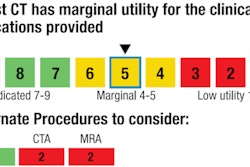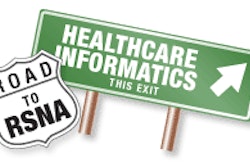Imaging providers hoping to get a piece of U.S. stimulus funds for adopting healthcare IT might be feeling spurned. The federal agency overseeing the program has once again omitted radiology in the draft proposal of stage 2 "meaningful use" criteria required to become eligible for the funds.
The omission may make it more difficult for imaging providers -- some of the earliest adopters of healthcare IT in the form of PACS and RIS -- to qualify for meaningful use stimulus funds. And it won't make the process any easier for RIS and PACS vendors to get their products officially certified.
But it may not be too late to get requirements that are "meaningful" to the radiology specialty included. Radiology professionals have until February 25, 2011, to comment on proposed stage 2 meaningful use draft criteria. At stake are payments of up to $44,000 per imaging provider -- or $1.5 billion in total -- just for radiology.
What 'meaningful use' means
The proposed stage 2 guidelines were published on January 14 by the agency administering the program for the U.S. Centers for Medicare and Medicaid Services (CMS), the Health IT Policy Committee of the U.S. Office of the National Coordinator for Health Information Technology (ONC).
Healthcare providers must demonstrate meaningful use of healthcare IT to qualify for federal stimulus funds, with CMS setting the criteria that must be achieved for both providers and healthcare IT products. CMS has taken a stepwise approach, creating three stages of meaningful use adoption, spread over a five-year time period, to enable healthcare providers to qualify for the stimulus payments.
Stage 1 requirements were finalized on July 13, 2010, with payments beginning 2011 for eligible healthcare providers. Nothing specific to radiology was included in stage 1, but advocates for the specialty were hopeful that medical imaging would be included in the second stage.
Instead, the proposed stage 2 criteria include no provisions for imaging informatics software. The only proposed requirement that mentions any radiology-related use of healthcare IT deals with the use of computerized physician order-entry (CPOE) software to order "at least one medication, and one lab or radiology order for 60% of unique patients who have at least one such order." Interestingly, the language of this proposed requirement states that CPOE-placed orders do not have to be transmitted electronically.
Ironically, this proposed requirement creates a scenario in which referring physicians will receive stimulus funding for using healthcare IT for ordering radiology studies, but radiologists will have to wait to be compensated for using healthcare IT software such as PACS and RIS to read the exams.
Why not radiology?
Why the exclusion of radiology? Representatives of ONC didn't provide a direct answer, other than to confirm that "images dropped off the list," according to George Hripcsak, MD, co-chair of ONC's meaningful use working group, and chairman of the department of biomedical informatics at Columbia University in New York City. Hripcsak recommended that radiology professionals comment now to ensure that radiology is included in stage 3 of the stimulus program -- which won't be finalized until 2015.
Radiology professionals can still apply for stimulus funding without being included in stage 1 or stage 2 requirements, but it's more cumbersome. For example, they would have to purchase additional software such as electronic health record (EHR) modules they might not use, or they would have to buy RIS or PACS applications that are already certified by the ONC; currently, only a handful are on the market.
The situation has frustrated many radiology proponents, including the American College of Radiology (ACR) of Reston, VA, which has been talking to the ONC about the needs of the radiology specialty since 2009, when the ONC was established and began operations.
The ACR plans to submit an official comment on stage 2 on behalf of its members, according to Michael Peters, director of legislative and regulatory affairs. He believes that the ONC's HIT Policy Committee would welcome constructive comments from all stakeholders, including individual radiologists, radiology practices, and hospital radiology departments.
The ACR's concern, regarding both the final stage 1 requirements released last year and these preliminary draft recommendations for stage 2, is that meaningful use should be meaningful for radiologists.
"Specifically, there should be meaningful use measures for eligible radiologists to promote the accessibility of images and imaging data via electronic health record technology," Peters observed. "Radiologists and other specialists generate data of immeasurable importance to patient care -- data which should be in the record."
He also noted that while the ACR understands why the ONC and CMS are prioritizing meaningful use criteria targeted to primary care physicians, more physicians are eligible than the subset on which the agencies are focusing. Peters emphasized that many specialists, such as radiologists, anesthesiologists, and pathologists, are susceptible to the penalties that will be levied on physicians who don't comply by 2015.
"More and better defined exclusion criteria are needed," Peters added. "The current exclusions offered by CMS from certain meaningful use measures are helpful, but they do not go far enough. For example, a radiologist should be excluded from recording smoking status on the basis of scope of practice alone, not only if the radiologist doesn't have patients who are 13 years or older. This is just one of many examples."
Tim Kulbago, chair of the Imaging e-Ordering Coalition's Provider Roundtable, and a vice president of Merge Healthcare of Hartland, WI, also strongly encouraged radiologists to comment. Members of the coalition, an all-volunteer alliance of healthcare providers, technology companies, and diagnostic imaging organizations promoting health IT-enabled decision support, have also regularly visited the ONC.
One positive step, for example, would be including in stage 2 a requirement that radiology exams be ordered using CPOE software. Kulbago said that based on the coalition's understanding, imaging-related requirements are to be addressed in stage 3, but there's no guarantee.
Other feedback requested by ONC
In addition to comments on its draft proposed requirements, ONC's HIT Policy Committee is requesting responses to the following:
- For future stages of meaningful use assessment, should CMS provide an alternative way to achieve meaningful use based on demonstration of high-performance clinical quality measures?
- What additional meaningful use criteria could be applied to stimulate robust information exchange?
- There are new objectives being considered for stage 3 where there is no precursor objective being proposed for stage 2. CMS is inviting suggestions on appropriate stage 2 objectives that would be meaningful stepping-stone criteria for the new stage 3 objectives.
The complete stage 2 proposal, including information on how to submit comments, can be accessed by clicking here.
As the February 25 deadline for comments nears, an ONC official reported that the agency has not heard from many individual radiologists, just from organizations representing the specialty. Will speaking up make a difference? It's time to find out.
By Cynthia E. Keen
AuntMinnie.com staff writer
February 3, 2011
Copyright © 2011 AuntMinnie.com



















